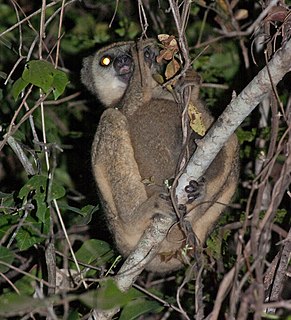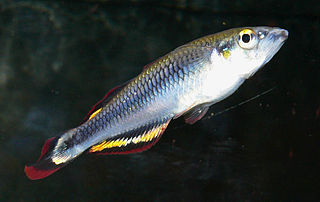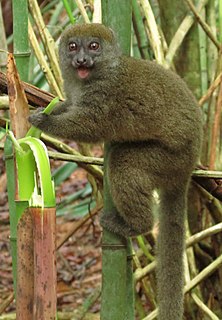See also
- Masoala fork-crowned lemur (Phaner furcifer)
Masoala is a genus of flowering plant in the family Arecaceae.
Masoala may also refer to:

The woolly lemurs, also known as avahis or woolly indris, are nine species of strepsirrhine primates in the genus Avahi. Like all other lemurs, they live only on the island of Madagascar.

The Madagascar lowland forests or Madagascar humid forests are a tropical moist broadleaf forest ecoregion found on the eastern coast of the island of Madagascar, home to a plant and animal mix that is 80 to 90% endemic, with the forests of the eastern plain being a particularly important location of this endemism. They are included in the Global 200 list of outstanding ecoregions.

The ruffed lemurs of the genus Varecia are strepsirrhine primates and the largest extant lemurs within the family Lemuridae. Like all living lemurs, they are found only on the island of Madagascar. Formerly considered to be a monotypic genus, two species are now recognized: the black-and-white ruffed lemur, with its three subspecies, and the red ruffed lemur.

Helodranon' Antongila, more commonly called Antongil Bay in English, is the largest bay in Madagascar. This bay is on the island's east coast, toward the northern end of the eastern coastline of the island. It is within Analanjirofo administrative region.

The helmet vanga is a distinctive-looking bird of the vanga family, Vangidae, and is classified in its own genus, Euryceros. It is mainly blue-black, with rufous wings and a huge arched blue bill. It is restricted to lowland and lower montane rainforests of northeastern Madagascar. Its diet is composed of invertebrates, predominantly insects. The species is threatened by habitat loss.
Nepenthes masoalensis is one of two tropical pitcher plant species from Madagascar, the other being N. madagascariensis.

Masoala National Park, in northeast Madagascar, is the largest of the island's protected areas. Most of the park is situated in Sava Region and a part in Analanjirofo. Created in 1997, the park protects 2,300 square kilometres of rainforest and 100 square kilometres of marine parks. The Masoala peninsula is exceptionally diverse due to its large size, and variety of habitats. Altogether, the park protects tropical rainforest, coastal forest, flooded forest, marsh, and mangrove. Three marine parks protect coral reefs and a dazzling array of marine life.

The Masoala fork-marked lemur, also known as the eastern fork-marked lemur or Masoala fork-crowned lemur, is a species of lemur found in the coastal forests of northeastern Madagascar. It is a small nocturnal animal with large eyes, greyish fur and a long tail.

Bedotia is a genus of the family Bedotiidae of fishes endemic to Madagascar.

Bedotiinae are a subfamily of the family Melanotaeniidae, known as the Madagascar rainbowfish, Madagascan rainbowfish, or Malagasy rainbowfish due to their endemism to Madagascar. It includes two genera, Bedotia and Rheocles.
Masoala is a genus of flowering plant in the family Arecaceae. It contains the following species, both endemic to Madagascar:
Voanioala gerardii, commonly known as the forest coconut, is a species of flowering plant in the family Arecaceae. It is a relative of the coconut, and is generally regarded as monotypic within the genus Voanioala. However, a team of geneticists headed by Bee F. Gunn found sufficient genetic variation within Voanioala to constitute at least two and possibly four cryptospecies. Voanioala is endemic to Madagascar, and is threatened by habitat loss. Voanioala is harvested for its edible seeds and palm heart. It is estimated that there are fewer than fifteen mature trees remaining.
Bedotia masoala is a species of rainbowfish in the subfamily Bedotiinae. It is endemic to Madagascar. Its natural habitat is rivers. It is threatened by habitat loss. This species was described in 2001 by John S. Sparks from a type locality of the Ankavanana River on the Masoala Peninsula in Antalaha District.
Marofinaritra is a commune and village in northeast Madagascar. It belongs to the district of Antalaha, which is a part of Sava Region.

Antalaha District is a district in northeastern Madagascar. The district contains the Masoala peninsula, and is limited by Antongil Bay in south-west and Indian Ocean on east. It is a part of Sava Region and borders the districts of Sambava into the north, Andapa to the north-west and Maroantsetra to the west. The area is 6,795 km2 (2,624 sq mi) and the population was estimated to be 222,203 in 2009 and 282,921 in 2018. At the time of the last Madagascar census in 1993 149,684 inhabitants lived in this district. The main town and district capital is Antalaha

The western lesser bamboo lemur, also known as the northern bamboo lemur, western gentle lemur, or Sambirano lesser bamboo lemur, is a species of bamboo lemur endemic to Madagascar.
Masoala is a village in Madagascar, in the Antalaha District of the Sava Region of the Antsiranana Province, on the South coast of the Masoala Peninsula.

Tropical Cyclone Bingiza was the only named storm to make landfall in the inactive 2010–11 South-West Indian Ocean cyclone season. The second of three storms, Bingiza developed on February 9 to the northeast of Madagascar. For a few days it meandered generally southwestward, failing to intensify significantly. On February 12, the storm began a steady westward track as environmental conditions became more favorable. In a 24‑hour period, Bingiza developed from a moderate tropical storm into an intense tropical cyclone with a well-defined eye. After attaining peak 10–minute sustained winds of 155 km/h (100 mph), the cyclone moved ashore in northeastern Madagascar on February 14 and quickly weakened as it crossed the country. Bingiza emerged into the Mozambique Channel as a weak tropical disturbance, and it turned southward to move across western Madagascar. Bingiza attained tropical storm status before making its final landfall near Morondava, degenerating into a remnant low on February 17, and dissipating two days later.
Schizolaena masoalensis is a plant in the family Sarcolaenaceae. It is endemic to Madagascar. The specific epithet refers to the Masoala peninsula where the species is found.
Ambanizana is a town and commune in Madagascar. It belongs to the district of Maroantsetra, which is a part of Analanjirofo Region. The population of the commune was estimated to be approximately 5,265 in 2018.